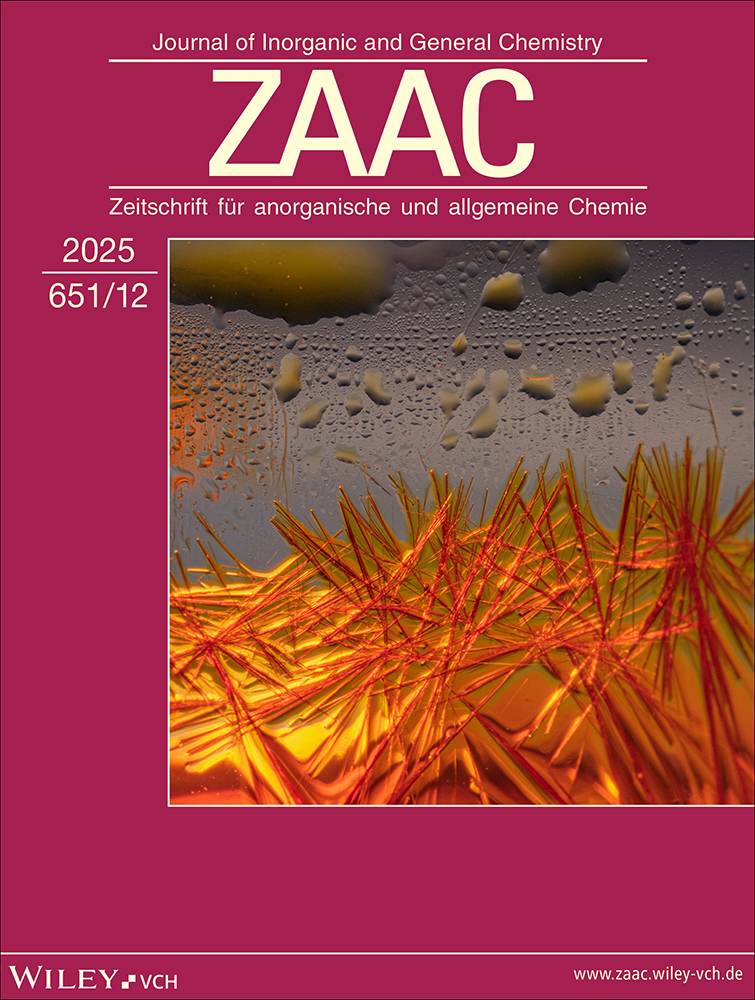[Cl3PNPCl3][MoNCl4], eine Verbindung mit strangartig assoziierten Anionen
Abstract
deDie Zielverbindung entsteht durch Umsetzung von [Cl3PNPCl3]Cl mit MoNCl3 in CH2Cl2 und anschließender Fällung mit CCl4 in Form orangeroter Kristalle. Nach dem 31P-NMR-Spektrum liegt die Verbindung in CD2Cl2/CH3CN-Lösung als strukturisomeres Phosphaniminat [Cl5Mo(NPCl2NPCl3)] vor. [Cl3PNPCl3][MoNCl4] kristallisiert isotyp zu [Cl3PNPCl3][MoOCl4] und zeigt die gleiche zweidimensionale Fehlordnung wie dieses. In den Röntgenbeugungsdiagrammen treten Ebenen von diffuser Streuung senkrecht zu c* neben Braggschen Reflexen auf. Aus den letzteren ergibt sich eine gemittelte Struktur einer Subzelle mit a = 1590,0, b = 1141,6, c = 418,0 pm, Raumgruppe Pba2, Z = 2. Aus der gemittelten Struktur (606 Reflexe, R = 7,1%) mit partiell besetzten Atomlagen läßt sich die tatsächliche Struktur und ihre Fehlordnung ableiten. Quadratische pyramidale [MoNCl4]−−Ionen sind zu Strängen mit abwechselnden MoN-Abständen von 175 und 243 pm gestapelt. Die Stränge sind fehlgeordnet gepackt, indem die [MoNCl4]−−Pyramiden entweder in die +c oder −c-Richtung weisen. Die [Cl3PNPCl3]+−Ionen sind zu Säulen parallel c gestapelt und auf zweierlei Art fehlgeordnet, nämlich durch Versetzung in Richtung c und durch Einnahme von dreierlei Positionen, die sich durch Drehung um 120° um die PP-Verbindungslinie unterscheiden.
Abstract
en[Cl3PNPCl3][MoNCl4], a Compound having Columns of Stacked Anions
The title compound is formed by the reaction of [Cl3PNPCl3]Cl with MoNCl3 in CH2Cl2 and subsequent precipitation with CCl4 in from of orange-red crystals. According to the 31P-NMR spectrum, the compound exists as its isomer phosphaneiminate [Cl5Mo(NPCl2NPCl3)] in CD2Cl2/CH3CN solution. The crystal structure of [Cl3PNPCl3][MoNCl4] is isotypic with that of [Cl3PNPCl3][MoOCl4] and shows the same kind of two-dimensional disorder. X-ray diffraction patterns show planes of diffuse scattering as well as Bragg reflexions. The latter correspond to an averaged structure with a = 1590.0, b = 1141.6, c = 418.0 pm, space group Pba2, Z = 2. In the averaged structure (606 reflexions, R = 0.071) the atom sites have fractional occupation. The real structure consists of square-pyramidal [MoNCl4]− ions stacked to form columns with alternating MoN distances of 175 and 243 pm. The packing of the columns is disordered in that the [MoNCl4]− pyramids point either in the +c or −c direction. The [Cl3PNPCl3]+ ions are stacked in the c direction and show two types of disorder, namely a displacement parallel to c and a rotation by 120° about the PP axis.




